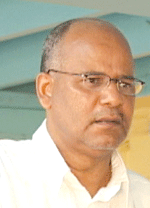THE Ministry of Home Affairs welcomes the introduction and operationalisation of the Evidence (Amendment) Act 2008.
 It is to be recalled that in August 2008, the then Attorney General and Minister of Legal Affairs, the Hon. Mr. Doodnauth Singh, introduced in the National Assembly a Bill entitled Bill No. 22 8.2008 Evidence (Amendment) Bill.
It is to be recalled that in August 2008, the then Attorney General and Minister of Legal Affairs, the Hon. Mr. Doodnauth Singh, introduced in the National Assembly a Bill entitled Bill No. 22 8.2008 Evidence (Amendment) Bill.
Acknowledged as a reformatory measure, the Bill sought the approval of the House to ensure:
“The appearance of detainees for obtaining bail, etc, from the place of detention before the Court by audio-visual links, the taking of evidence by the Courts and making
submissions before them by audio- visual links from any place in Guyana or outside, subject to certain safeguards”.
According to the Bill’s Explanatory Memorandum, the amendment to the Evidence Act sought to give: “legal recognition to the taking of evidence by the Courts in
Guyana using audio- visual link facilities in Civil and Criminal proceedings and to give legal recognition to the conduct of the identification of parades by using audio visual link facilities.”
During the debate, I supported the Bill wholeheartedly and stated that the audio- visual link:
“will not deny a prisoner his Constitutional Right to be in and out of a prison environment neither will it deprive any prisoner their right to appear in Court”
Mrs Clarissa Rheil, on behalf of the Opposition PNC in her contribution made the astounding statement that with the introduction of the audio video link the Government:
“appears to want to get out of its responsibility.”
Mrs Rheil went on to emphasise that the video link will “deny the prisoner his/her day in Court and will make the prisoner a more hardened criminal”.
This was the first clear indication that the Opposition was not inclined to support passage of the Bill.
For the AFC, Mr. Khemraj Ramjattan in rejecting the need for the introduction of the audio video technology in Court proceedings stated:
“We are ill prepared, it is just that we want to show off a little; we are going to…have the video link mechanism”
Meanwhile, in her contribution, Member Backer stated that: “If it is to improve the speed of trials it is not going to work…It will not help the Administration of Justice…”
Ms Backer went on to state:
“……..in its present form we cannot support this Bill.
It will not do what it sets out to do; we are uncomfortable with how wide sweeping it is and for now we feel that restricting it to people who are overseas is a good way to start”.
It was clear therefore that the Opposition benches did not have any interest in nor could be counted on to support the Bill.
However, the Bill was passed and eventually was assented to by President Jagdeo. It has come to my knowledge that since then the Audio Video link was utilised on two (2) occasions. On one (1) occasion in the Criminal Jurisdiction, and the other in the Civil Jurisdiction.
The Director of Public Prosecutions (DPP) is on record stating on the first occasion that the Audio Video link was used to extract:
“Criminal testimony of witnesses who have
not only migrated outside of the jurisdiction but those who are no longer at the same location in Guyana that they were at the time of the incident”
And contrary to Ms Backer’s contribution that the Audio Video link will not speed up trials, the DPP emphasised that the use of the audio-visual link: “will ensure speedy trials”
I join with the DPP in celebrating the successful inauguration of the audio video link in our court system. It is another landmark achievement; contrary to the scoffing on the initiative by Opposition members at the time the Bill was debated in the National Assembly.
CLEMENT J. ROHEE
Minister of Home Affairs



.jpg)








